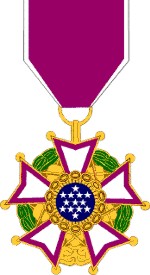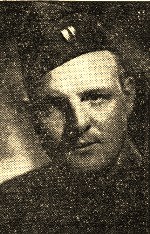

|
Captain

John Moffatt |
 |
|
Captain Moffatt (then a Lieutenant) was awarded the Legion of Merit for outstanding services during the New Georgia Campaign in December 1943. This is the story of how he and eight other officers from the Army, Navy and Marines went into Japanese territory more than two weeks before American forces landed on Rendova to start the New Georgia Campaign. All nine officers were charged with the important mission of reconnoitering Rendova for good landing beaches, bivouac areas, observation posts, artillery positions, fresh water points and discover Japanese positions to insure perfect landing operations on June 30—D-Day. At dusk on June 13, Lt. Moffatt and the others left the Russell Islands in an APC, a small, shallow-draft, destroyer type troop carrying ship that could speed through the enemy waters without being detected as readily as a larger ship. That night they slid past Japanese positions on the southeastern coast of New Georgia, and by 6 a.m. the next morning they were at Segi on New Georgia. It was a tense moment as the men on the ship awaiting a sign from the shore. Suddenly, from what seemed out of nowhere, ten native canoes appeared, and they proceeded cautiously to the ship. “It was a pretty tough period,” Lt. Moffatt recalls, “because we didn’t know just where the Japanese were around there, and they might have opened up on us from the shore at any time.” Late that afternoon the nine men took off for Rendova in three canoes which were manned by eight natives. The officers directed the natives to pass along north of Tetipari Island, which lies off the southeastern tip of Rendova, but the natives, believing there was a Japanese outpost at the western tip of the small island, refused, and headed, instead, along the southern coast. At dawn on June 16, the party landed at the Lukra district of Rendova, the very southern tip, and made a reconnaissance of the area. They searched for Japanese all day, but found none. It was not until that night, when they met one of the local native chiefs, that they discovered there had been a Japanese outpost two miles from them. That night they reached Rano village and stayed at the hut of the native chief, Samuel. There they met the chief of Banieta village, which is on the western coast of Rendova, who told them there were thirty Japanese there at the time. That night the men met a native guide, Joe, who was to take them to northern Rendova. The next morning started with afoot through the dense jungle undergrowth and along a narrow native path toward the village of Zaranga, a village which had just been set up by natives fleeing the Japanese on the island. At Zaranga, the men met Zima Nira, a missionary-educated native who was chief of all the island natives. “Believe it or not,” Lt. Moffatt said, “the natives broke out some clean white sheets for us and surprised us further by having pillows for us too. The bed was a long narrow affair, and they covered it with banana leaves. We put the sheets on top of the leaves, and all nine of us slept on the same bed.” One June 17—thirteen days before D-Day—the men began the most tedious journey of their entire trip. They walked along the coast line to Buzuna Cove, and from there they had to cut a new trail through the jungle in order to reach their destination without being seen by the Japanese. Through the eerie jungle, with its screeching birds and its slithering insects, the men pushed on all day, cutting a path that ran up to the peak and along the crest of a 3,500 foot mountain. They walked, crawled and stumbled on, scratched by jungle vines. Finally, they came to the Siroka River in the northwestern section of Rendova, refreshed themselves and went on. For the next three days the group made a thorough reconnaissance of the northern sector of Rendova. They checked landing beaches, fresh water points and gun positions. Across the straits they, studied Munda airport with its defenses. Every morning at precisely 8 a.m. they would watch American planes swoop down and blast the airport. On one occasion they nearly stumbled into a Japanese work party at Rendova Plantation, and they came within several yards of Japanese guards. Concealed by the dense vegetation, they watched Japanese working away on the plantation, stripping the huts of their iron and plundering the gardens. On the June 21, Lt. Moffatt and the others started their return trip. They had left three officers on Rendova to stay there until landing forces occupied the island. The returning group went to Ugeli, on the northeastern coast of Rendova, met some native canoes that afternoon and then went down to Zaranga village, where they stayed that night. The next afternoon the officers got into one long, narrow canoe manned by twenty-four natives and started off for Segi. That they finally made it the next day can be attributed more to luck and help from the Japanese than anything else, according to Lt. Moffatt. For that night they ran into a typical tropical storm that threatened to upset the canoe at any moment, a storm which threw them off course thoroughly and completely. The men could only see rain and more rain during the night. Their compass was also broken and their canoe being tossed about. Finally, they saw Japanese searchlights probing through the night from around Munda, and, from that, they set their course. Later, they found the wind had blown them almost as far north as the northern tip of Rendova. After spending eighteen hours in the canoe, the group finally reached Segi, and the next morning they got into native canoes again and went out to meet a Navy destroyer which took them to Guadalcanal. Six days after Lt. Moffatt and the others came back with their valuable information, American forces landed at Rendova. The rest of the New Georgia Campaign is history. |